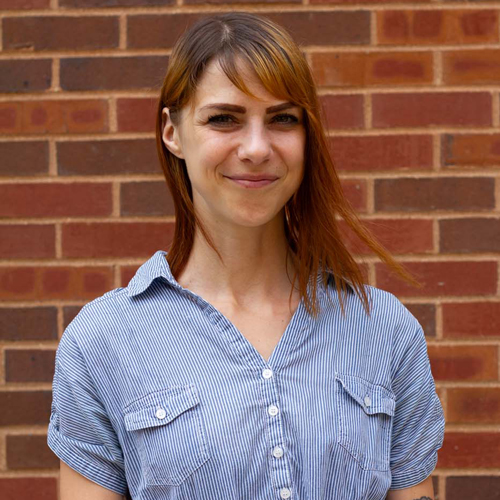Understanding the Impact of Context on our Brains and Behavior
This fall, the Department of Psychology welcomes two new professors–Kurt Fraser, PhD in Cognitive and Brain Sciences (CAB) and Whitney Ringwald, PhD in Clinical Science and Psychopathology Research (CSPR). Both Fraser and Ringwald are driven to understand emotion and behavior as it occurs within the complexity of the real world, asking what is the impact of context and the environment on our brains and behavior? Fraser, most recently a postdoctoral associate at the Department of Molecular & Cell Biology at the University of California Berkeley, is driven to investigate how and why we behave in certain ways, what are the brain mechanisms that facilitate our motivation, and how context can affect both. Ringwald studies individual differences in functioning as the product of dynamic transactions between people and their environment. She just completed her doctoral degree in Psychology at the University of Pittsburgh. Both are eager adopters of new technologies and techniques in their research, building on a long tradition of methodological innovation in the UMN Department of Psychology.
When does a pint glass = beer?

Fraser is an animal researcher, primarily using rodent models. Fraser feels lucky to have been involved with research early on as an undergraduate at the University of Michigan; “that’s where my interest in science occurred…[and] where my interest in animal behavior and neuroscience sparked. [My subsequent work with] dopamine and motivated behavior is all rooted in that undergrad experience.” As a graduate student at Johns Hopkins and a postdoc at Berkeley, he built on that spark and grew his research program.
Fraser explained that because we do not yet have the tools needed to examine exact neural processes in humans as they behave in real time, researchers need to use animals to uncover the neural substrates underlying motivation and behavior. Researchers can control the life experiences and environment of animals, thereby bringing us closer to understanding what is actually happening in their brains. Fraser uses rodents specifically to explore the psychological and neurobiological processes that contribute to their motivation to pursue rewards like food, sex, and drugs. In particular, he is interested in why certain places and things–occasion setters–can become powerful motivators that guide behavior in adaptive ways, and how these processes can also become maladaptive, such as with addiction. Exploring these processes in animals allows Fraser to translate what to look for in human behavior. For example, seeing a pint glass may mean that beer is in our future. Just because we have learned that a pint glass can mean beer, however, does not mean that we necessarily act on that impulse in every instance. There are often cues, stimuli, and/or contexts in the mix that modulate the extent to which we will act, such as thirst, time of day, encouragement from peers, and these are the occasion setters.
Often in animal research, animals are trained to complete simple tasks in environments that are typically not very complex. In contrast, humans complete tasks in very complex situations; humans complete tasks in their daily lives during which the meaning of everything is being modulated; “This modulatory influence is apparent in our lives, or at least for mine for sure. Why is it that the allure of the McDonald’s sign depends on how hungry we are? Why is it challenging for kids to learn the difference between using their inside and outside voice? Why do some people crave cigarettes after having an alcoholic beverage?” In order to add complexity to the environments his research subjects face and, thereby, better approximate the complexity of human life, Fraser’s research program utilizes new techniques that allow him to study and treat the animal in the moment as he and his team train and make alterations to their environments. They use in-vivo electrophysiology to record the activity of well-defined individual neurons, as well as a technique called fiber photometry that combines optical imaging with genetically engineered neurotransmitter receptors. Fraser described,
“We are now at a point where we can record numerous neuromodulators right as an animal is doing a specific task. As a result we can form new models about the complex interactions of these modulators, how they affect neural activity, and ultimately ask how that is contributing to the animal’s behavior. [That allows us to] understand the function of those circuits [so that] we can then precisely probe [and] even rewire the brain. Taking advantage of optogenetics, a technique where we can use laser light to turn on and off neurons, we can decide when to turn off or on a given neural circuit with the flick of a switch and see how that affects behavior. Collectively our goal in the lab is to use techniques that allow us to answer how the brain constructs behavior directly as that behavior is happening. ”
If we can better understand the complexity of environments and how the brain functions, we can better modify and treat behavior and the human condition through different approaches. Now as an assistant professor at the University of Minnesota, Kurt Fraser is eager to continue and grow this line of research. And, just like his research subjects, he too will be navigating his own new and complex environment.
When does a trigger become a stressor?

Ringwald is interested in individual differences, specifically how and why people differ in the “sets of problems” they experience. During her time working as a clinical social worker and drug and alcohol counselor, she saw firsthand the ways in which problems manifested differently across individuals. For example, one patient would drink alone when stressed to numb their sadness whereas another patient would go to parties to have fun when stressed, which would lead to out-of-control behavior and legal problems. In seeking to diagnose and treat these individuals, she became frustrated with the diagnostic tools available, like the Diagnostic and Statistical Manual (DSM). Even though both patients would be diagnosed with alcohol use disorder according to the DSM, the contexts and motives driving their problems are very different and they would require different treatment approaches. According to Ringwald, “the DSM does a poor job of drawing the lines between the important ways that people differ from each other. There’s too much overlap in diagnoses…people with the same disorder can look very different.” Ringwald was motivated to find different, better ways to describe the problems she was seeing in patients, which led to her interest in empirical classification systems, like The Hierarchical Taxonomy Of Psychopathology (HiTOP). An overarching goal of HiTOP is to address problems with the DSM by developing diagnostic tools based on empirical evidence gathered from working with people with psychopathology and UMN Psychology is “ground zero for that kind of work.” Ringwald described that empirical classification is a data-driven approach that allows researchers and clinicians to identify the ways in which symptoms co-occur between people in order to better describe them, thus “[giving] us a blueprint to describe how people function.”
Ringwald is taking this exciting new work in the classification of psychopathology one step further, seeking to examine how context impacts individual differences in psychopathological responses. For instance, referencing the previous example, why does a stressful situation in daily life trigger problems with emotionality for some people and disinhibition problems for others? Key to effectively tailoring treatment is being able to answer a question like this. Ringwald described that from a clinical perspective, the trigger is what is “eminently intervenable,” perhaps via therapy. The question is, though, how to identify those triggers and how to connect them with particular emotional and behavioral responses.
In order to add context into the equation, Ringwald utilizes methodologies that allow her to study people in their 'real life' environments, over time and in contexts that matter. Simply put, Ringwald is interested in “sampling people a whole bunch over time as they go through their day and lives.” Known as ecological momentary assessment (EMA), Ringwald collects this data of everyday life in a myriad of ways: via smartphone and watch sensors, leveraging AI to record participant facial expressions and natural language use from videos, and self-reports by participants who complete daily assessments. According to Ringwald,
“[Via these methods], I can quantify behavior in [someone’s] real life as it is happening, [in addition to that person] reporting on their context. [That additional data helps me to recognize that] when someone is in this interaction, this is how [they] feel, allowing me to understand those differences and patterns….I think it’s important to incorporate as many methods as possible to get the full picture. People are great at reporting stuff, but there’s so much that they don’t know or notice, so triangulation is important. I’m really excited about AI and passive sensor data [so that I can get] info about how people are moving around and with whom they’re interacting…without bothering them.”
Ringwald noted that understanding individual differences is a key starting point in determining how best to help those who need it, but in her perspective, “it’s about the person and environment.” To do so, we need to understand a person’s characteristics, what they are motivated by, what are their triggers, and what are the environmental issues that impact them.
Both Fraser and Ringwald are eager to work with students and will be accepting undergraduate students in their research labs this fall, and graduate students for admission in 2025.
Learn more about Fraser’s and Ringwald’s research.
de Jong, Johannes W., Kurt M. Fraser, and Stephan Lammel. “Mesoaccumbal dopamine heterogeneity: What do dopamine release and firing have to do with it?” Annual Review of Neuroscience 45 (2022): 109-129. https://doi.org/10.1146/annurev-neuro-110920-011929
Fraser, Kurt M., Val L. Collins, Amy R. Wolff, David J. Ottenheimer, Kaisa N. Bornhoft, Fiona Pat, Bridget J. Chen, Patricia H Janak, and Benjamin T. Saunders. “Contexts facilitate dynamic value encoding in the mesolimbic dopamine system.” bioRxiv [Preprint] (November 5, 2023). https://doi.org/10.1101/2023.11.05.565687
Fraser, Kurt M., Heather J. Pribut, Patricia H. Janak, and Ronald Keiflin. “From prediction to action: dissociable roles of ventral tegmental area and substantia nigra dopamine neurons in instrumental reinforcement.” Journal of Neuroscience 43, no. 21 (May 24, 2023): 3895-3905. https://doi.org/10.1523/JNEUROSCI.0028-23.2023
Fraser, Kurt M., and Patricia Janak. “Occasion setters attain incentive motivational value: implications for contextual influences on reward-seeking.” Learning & Memory 26 (September 13, 2024). https://doi.org/10.1101/lm.049320.119
Fraser, Kurt M., and Peter C. Holland. “Occasion setting.” Behavioral Neuroscience 133, no. 2 (2019): 145–175. https://doi.org/10.1037/bne0000306
Fraser, Kurt M., Tabitha H. Kim, Matilde Castro, Céline Drieu, Yasmin Padovan-Hernandez, Bridget Chen, Fiona Pat, David J. Ottenheimer, and Patricia H. Janak. “Encoding and context-dependent control of reward consumption within the central nucleus of the amygdala.” iScience 27, no. 5 (May 17, 2024). https://doi.org/10.1016/j.isci.2024.109652
Ringwald, Whitney R., Scott Feltman, H. Andrew Schwartz, Dimitris Samaras, Christopher Khudari, Benjamin Luft, and Roman Kotov. “Day-to-day dynamics of facial emotion expressions in posttraumatic stress disorder.” PsyArXiv Preprints (2024). https://doi.org/10.31234/osf.io/6fqg9
Ringwald, Whitney R., Elizabeth A. Edershile, Janan Mostajabi, Sienna Nielsen, William C. Woods, Leonard Simms, and Aidan G.C. Wright. Daily manifestations of psychopathology in response to stress. PsyArXiv Preprints (2024). https://doi.org/10.31234/osf.io/enzdv
Ringwald, Whitney R., Miriam K. Forbes., and Aidan G. C. Wright. “Meta-analysis of structural evidence for the Hierarchical Taxonomy of Psychopathology (HiTOP) model.” Psychological Medicine 53, no. 2 (2023): 533–46. https://doi.org/10.1017/S0033291721001902.
Ringwald, Whitney R., Michael N. Hallquist, Alexandre Y. Dombrovski, and Aidan G. C. Wright. “Personality (dys)function and general instability.” Clinical Psychological Science 11, no. 1 (August 18, 2022): 106-120. https://doi.org/10.1177%2F21677026221083859


